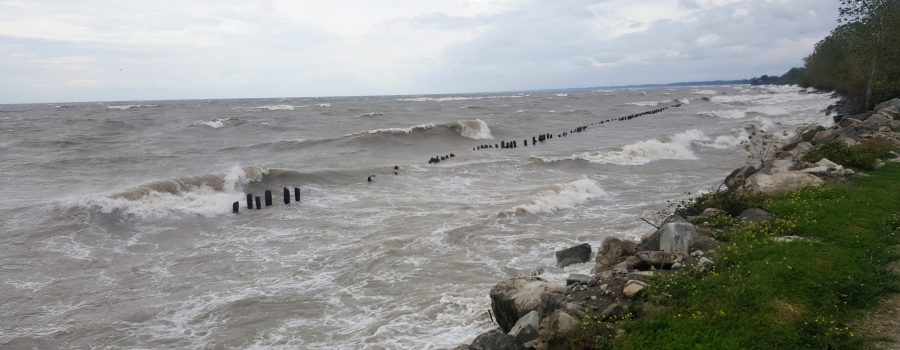Highlights:
• Current water levels on the lakes are near their record highs set last year.
• Moderate sustained winds, thunderstorms and/or heavy rains could cause flooding, erosion and shoreline damage
• Risk of shoreline flooding on both lakes
• Risk of erosion and damage to shoreline protection works on both lakes
Message:
Current average daily water levels on Lake Erie (at the beginning of the month) sit at around 175.12 m (I.G.L.D.). This water level is only 2 cm below the all-time record high monthly average for June set last year, and 7 cm below last year’s peak daily average water level set on June 22nd. Water level forecasts are currently predicting a slight drop in lake levels of 2 to 3 cm over the month of June.
Current average daily water levels on Lake St. Clair (at the beginning of the month) sit at around 176.00 m (I.G.L.D.). This water level is 1 cm above the all-time record high monthly average for June set last year, and 8 cm below last year’s peak daily average water level set on July 7/8th. Water level forecasts are currently predicting a slight rise in lake levels of 2 to 3 cm over the month of June.
As can be seen by the water elevations referenced above, current water levels on the lakes are very close to the peak water levels observed last year. The difference between current water levels and peak water levels last year are not significant in terms of the flood risk they present. Sustained winds can cause an effect known as setup where water from one end of the lake gets pushed to the other, creating a rise in water levels at the far end of the lake. In the LTVCA jurisdiction, on both lakes, the water level rise from this effect can exceed the difference between current lake levels and last year’s peak water levels. In addition, wave heights on the lakes can far exceed this difference. The current risks of flooding and shoreline damage are essentially the same as they were last year during the peak water level summer months. The extent of any flooding and shoreline damage we may experience will be determined by the wind speed, wind direction and the waves they create.
Strong sustained winds can lead to water level changes and waves that cause shoreline issues. Strong winds out of any direction could have an impact on some area along our local shorelines. In the most vulnerable areas such as Erie Shore Drive in Chatham-Kent wave spray related flooding can occur at wind speeds as low as 25 km/hr, while other less vulnerable areas may need wind speeds closer to 45 km/hr. Gale force winds of 60 km/hr could be expected to cause significant flooding and shoreline damage to any low lying shoreline area. The area’s most frequently impacted communities and the relevant wind direction include: Lighthouse Cove when winds are out of a north through west direction; Erie Shore Drive when winds are out of the south (SW through SE); the bay side of Erieau when winds are out of a north through east direction; Shrewsbury when winds are out of the east (NNE through ESE); and Rose Beach Line when winds are out of a south through northeast direction. Of course, other shoreline areas are also susceptible.
The bluff areas all along the Lake Erie shoreline are also at a greater risk of erosion due to the high lake levels, especially when there are onshore winds and waves. Along the bluffs, the erosion can cause the bluffs to fail and there have been instances of land many metres deep falling into the lake all at one time. Exactly when the bluff may collapse is not something that can be predicted.
Weather systems associated with sudden strong winds, like pressure systems or frontal systems, can also create sudden lake setup effects. Summer thunderstorms are often associated with these systems. This effect has caused flooding with the high lake levels over the last couple of years, including an incident last week (the end of May) in Lighthouse Cove. Predicting when such flooding may occur is extremely difficult. The Lighthouse Cove area appears to be the community in the LTVCA most affected by this.
Heavy rains could also cause flooding in low lying shoreline areas. Due to the high lake levels, the groundwater table is high and storm water sewer systems and local watercourses are full with lake water. As a result, rainwater is not draining properly from these areas. Any water from upstream making its way downstream on local watercourses into these shoreline areas could cause additional flooding.
Shoreline residents need to pay attention to local conditions and prepare accordingly. The low wind speeds that lead to wave-related flooding in some areas is very difficult to forecast. As we move into summer, forecasting shoreline flooding becomes even more challenging. Conditions over the lakes can change quickly and with little warning.
Please contact your local municipality should significant flooding and/or erosion events occur, or should events occur that may impact roadways and other public infrastructure. If there is an imminent risk to personal safety, call 911.
Most importantly, people need to keep themselves safe. Should an event occur, people should take extra caution and avoid the shoreline and any waterways with elevated water levels. The waves on the lakes can be strong, and the shoreline and the banks of waterways can be slippery and unstable. There could also be hazardous debris within the waves and water which could be thrown onto the shoreline. Standing water can also present unseen hazards. Children and animals should be kept away from the water.
This is a standing message issued for the month of June. Should weather forecasts suggest a sustained wind event likely to cause shoreline issues, this message will be upgraded.
Message Contact: Jason Wintermute ([email protected])

